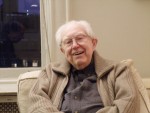Title
This year’s New York Woodwind Quintet Daniel Saidenberg concert will be particularly exciting: a tribute to Elliott Carter featuring the premiere of his new work Nine by Five, commissioned by The Juilliard School for the N.Y.W.Q.
Body
The concert will include his two earlier works for winds, the Eight Etudes and a Fantasy from 1950 and the Woodwind Quintet from 1948, both of which changed the way composers wrote for woodwinds. It will also include the premiere of his new work for solo French horn, Retracing II and, with students from the New York Woodwind Quintet Seminar, the U.S. premiere of Wind Rose, a work he wrote in 2008 for 24 woodwind players. Finally, at Carter’s request, the concert will include Jean Françaix’s well-known quintet from 1948, written the same year as Carter’s early opus.
I had been talking with Carter for several years, trying to get him interested in writing a second woodwind quintet. His first quintet had become a classic a long time ago, and the wind chamber music world had been waiting with bated breath for a second. At the end of September I received word. Elliott Carter was definitely beginning work on a piece for the New York Woodwind Quintet. He had decided to make it a work for multiple instruments, and the contrabassoon was to play a very important role. The sketches were exciting to see. Once again, Carter had reconceived a genre; approaching his 101st birthday, his originality and the freshness of his inspiration seemed, if anything, to be more acute.
Carter completed his new quintet on his 101st birthday, December 11, 2009. He named it Nine by Five because the five members of the quintet play nine instruments—flute, piccolo, oboe, English horn, clarinet, E-flat clarinet, bassoon, contrabassoon, and French horn, which he uses both muted and unmuted.
Shortly after he finished the work, I had the pleasure to talk with Carter about Nine by Five and also about the other works on the New York Woodwind Quintet program. He was tremendously animated and typically insightful. While the entire interview will appear in the concert program, following is a short excerpt where he describes his new quintet.
CN: We have been talking through the years about the woodwind quintet and about the difficulties of writing for it.
EC: Yes, I haven’t written pieces for groups of woodwinds for a long time. I really don’t know why. And it only became more interesting to me, a.) because you were asking me about it, and then I remembered that a piece I did like a good deal was the piece called Tre per Sette by Goffredo Petrassi, who was a friend of mine ... he had three players who played seven instruments. I liked that piece very much, so when you started talking about a woodwind quintet I thought it might be interesting to do that type of thing for a woodwind quintet. I didn’t go as far as I might have—after all, I could have had a bass and alto, an ordinary flute and a piccolo ... and similarly with the clarinet. But I decided I would just have two instruments, flute and piccolo, clarinet and E-flat clarinet, and bassoon and contrabassoon. And then, of course, immediately you start to think about how long it takes to change from one to another. And that became part of the problem of composing a work of this type. It was very obvious to me, for instance, that it is not easy to move from a bassoon to a contrabassoon ... and that meant that I had to have rather large empty spaces in the lower register .... And the other problem of dealing with all of this was making it justifiable to have particular instruments playing, let’s say, a piccolo and a contrabassoon at the same time, and also how to fill in the other instruments—the whole question of sonority.
I’ve been writing pieces that are much more linear than I used to. There are duets and the only time all five instruments play together is in the slow section in the middle of the piece, and there they … play in close harmony together. I took a chance with that because ... the instruments are not distributed according to their own range but according to the voice leading of the piece, which means that sometimes the flute’s playing below the clarinet or the oboe or the English horn. I decided that whenever the instruments were not playing a long line ... I would have all the instruments, instead of playing together, playing little fragments, which would change the music that came before. I also decided that I would try to give each instrument a repertory of intervals—like a leitmotif that keeps coming back every once in a while.
My music takes a performer who can understand that what he’s playing is not as irregular as it seems. There’s basically a pattern but maybe it’s notated in a rather curious way.
CN: That’s because you have parts moving in different tempi.
EC: That’s right.
CN: Controlled by the overall pulse, so they can look very complicated but they should sound like expressive musical lines.
EC: I have quite a lot of that in Nine by Five.





